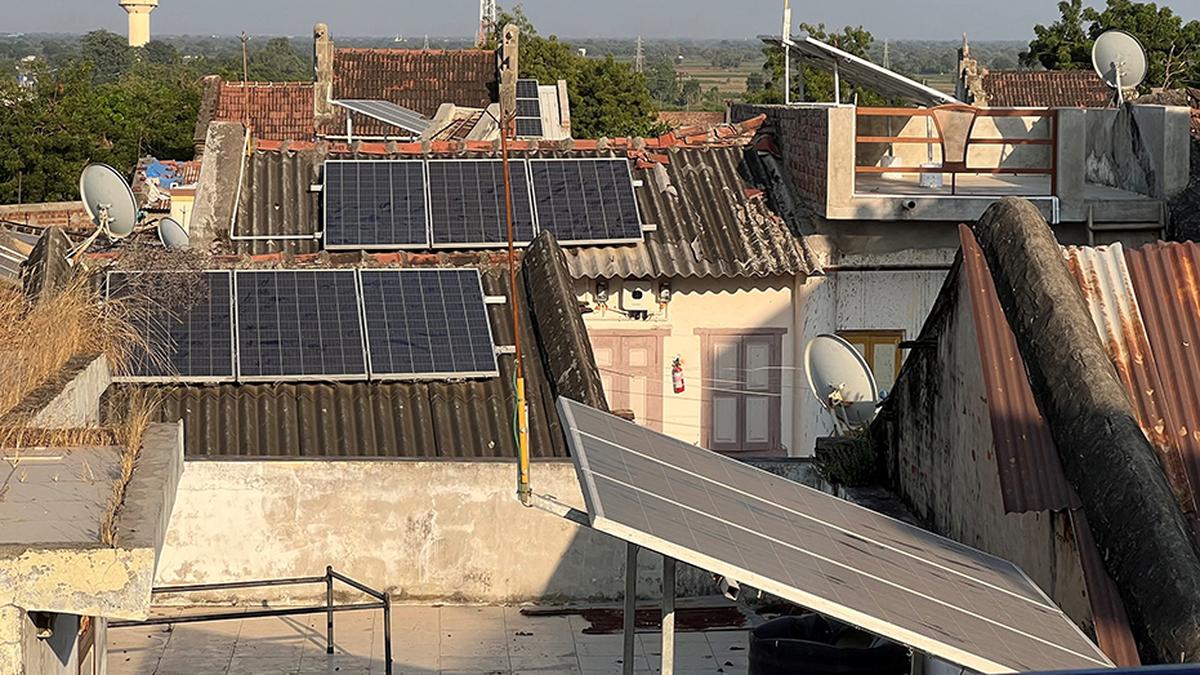Representative image. File
| Photo Credit: Reuters.
Despite a near four-fold increase in applications between March 2024 and July 2025, only 13.1% of the target 1 crore solar rooftop installations, under the PM Surya Ghar Yojana has been achieved, and just 14.1% of the allocated ₹65,700 crore in subsidies released till July 2025, a report said.
“In this scenario, the FY2027 target [of 1 crore installations] continues to be viewed as a considerable challenge,” said a report on the performance of the scheme, jointly published by the Institute for Energy Economics and Financial Analysis (IEEFA) and JMK Research & Analytics on Tuesday.

Reasons include a tardy approval processes, which could stretch anywhere from 45 to 120 days, stemming largely from “meter shortages, lack of coordination between consumers, installers, and DISCOMs, and procedural inefficiencies at the utility level,” the report noted.
The PMSGY is a Centre-led endeavour to encourage more homes to install roof-top solar connections. The government provides capital upfront via loans and improves the overall service delivery for aspirants in liaising with private companies that provide installation services. The Centre had set a target of 1 crore installations by 2027.

As of July 2025, the period until which the report tracked progress, the PMSGY had received 57.9 lakh applications for residential rooftop solar installations. The scheme has facilitated the installation of 4,946 MW of rooftop solar capacity till July 2025 across various States and Union Territories, indicating “robust on-ground execution,” the report says. Subsidy disbursements have crossed ₹9,281 crore ($1.05 billion), benefiting over 16 lakh households. As of July 2025, the 4.9 GW of installations added under the PMSGY accounted for approximately 44.5% of the country’s total residential rooftop capacity.

So far, the report said, Gujarat leads all States with the highest installed residential rooftop solar capacity of 1,491 MW, followed by Maharashtra, Uttar Pradesh, Kerala, and Rajasthan. The top five States together accounted for approximately 77.2% of the total installed capacity.
The PM solar scheme only incentivises solar installations, whose component parts are entirely manufactured in India. Called “DCR-compliant modules”, they are on average costlier by ₹12/watt over imported variants.
“These higher prices are making larger residential installations less economically attractive and, in some cases, eroding the effective benefit of the ₹78,000 (USD 897.1) subsidy. At the same time, domestic DCR module supply remains fragmented and limited, resulting in delivery delays of up to two months. These delays are prompting many consumers to opt for non-DCR systems and forgo the subsidy in favour of faster installations,” the report underlined. “Without stronger measures to prioritise domestic supply for PMSGY over exports and address anti-dumping-related cost pressures… the affordability and timely rollout of residential rooftop projects are likely to remain at risk.”
“Establishing clear, time-bound rooftop solar capacity targets at the State level is essential for creating a coherent vision and ensuring effective policy execution,” said Vibhuti Garg, Director, IEEFA-South Asia, and a contributing author, said in a statement.
In a press statement last week, the Ministry of New and Renewable Energy said that as of September 2025, Public Sector Banks (PSBs) have sanctioned over 5.79 lakh loan applications, amounting to ₹10,907 crore for the scheme.
Published – October 14, 2025 10:30 am IST

